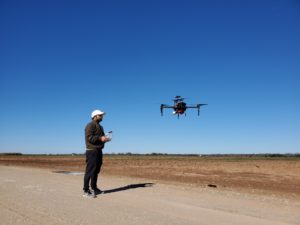 Crop breeders collect data on the characteristics and responses of crop plants (e.g., plant height, or canopy volume) so they can make informed decisions about genotype selections. A question a breeder would ask might be, which genetic variety is most resilient in drought conditions? The process of collecting data on growing plants is called phenotyping. The number of phenotypic observations has historically been limited by the number of people involved in the data collection operation as well as the difficult working conditions. Therefore, the number of genotypes considered has also been limited. In order to make faster progress in crop improvement, breeders desire to consider a larger number of genotypes. Sensors mounted on autonomous platforms like robots and drones have the capability to collect tremendous amount of data, much more than humans, are less affected by working conditions, and can collect data that heretofore have been unavailable. This new method of phenotyping is called high-throughput phenotyping (HTP). The Cotton Engineering program has been conducting research in HTP for cotton breeding.
Crop breeders collect data on the characteristics and responses of crop plants (e.g., plant height, or canopy volume) so they can make informed decisions about genotype selections. A question a breeder would ask might be, which genetic variety is most resilient in drought conditions? The process of collecting data on growing plants is called phenotyping. The number of phenotypic observations has historically been limited by the number of people involved in the data collection operation as well as the difficult working conditions. Therefore, the number of genotypes considered has also been limited. In order to make faster progress in crop improvement, breeders desire to consider a larger number of genotypes. Sensors mounted on autonomous platforms like robots and drones have the capability to collect tremendous amount of data, much more than humans, are less affected by working conditions, and can collect data that heretofore have been unavailable. This new method of phenotyping is called high-throughput phenotyping (HTP). The Cotton Engineering program has been conducting research in HTP for cotton breeding.
Projects:
-
Enhancing Accuracy and Reliability of Image Data from UAV Remote Sensing
Images that are captured with UAVs can potentially be used to make decisions about when and where to apply irrigation water, defoliant, pesticide, etc. It is critical that these images contain information that is consistently accurate and trustworthy. The Cotton Engineering program has been conducting research on methods to calibrate UAV image data, and the accuracy of the data has been vastly improved with the methods developed in this project. The methods involve not only UAVs but also ground-based robots that position themselves under the UAV during image collection serve as references for calibrating the data.
-
Robotics and Biophotonics Enabled Plant and Pathogen Phenotyping
Plant breeders conduct research to find crop plants that have higher yield, are resistant to pests, are drought-resistant, or have other desirable characteristics. They grow numerous plots of various genetic varieties of and record data on important parameters of the plants so they can make decisions about which genotypes to select for future study and development. Collecting data on these parameters is called phenotyping, and modern methods of “high-throughput phenotyping” (HTP) incorporate robotic platforms that carry sensors to collect the data. The Cotton Engineering program is conducting research on combinations of sensors and robotic platforms for HTP in order to provide cotton breeders new tools for crop improvement.